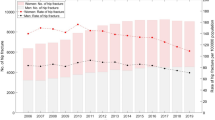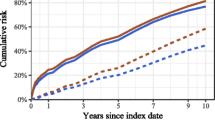Abstract
Summary
Temporal trends in hip fracture incidence have recently been reported in some developed countries. Such data in Spain has previously been incomplete; this study reports the stratified incidence of hip fractures in people over 65 in Spain during the last 14 years.
Introduction
The main objective is to establish whether temporal trends in hip fracture incidence in Spain exist.
Methods
Ecological study with data from hospital discharges nationwide. The study includes patients aged ≥65 years during a 14-year period (1997–2010). The analysis compares two periods of four years: 1997–2000 (P1) and 2007–2010 (P2).
Results
There were 119,857 fractures in men and 415,421 in women. Comparing periods (P1 vs P2) over 10 years, the crude incidence rate/100,000 inhabitant/year increased an average of 2.3 %/year in men and 1.4 % in women. After adjustment, the rate increased an average of 0.4 %/year in men (p < 0.0001), but decreased 0.2 %/year in women (p < 0.0001). In men, younger than 85, the decrease was not significant except in 70–74 years, and from 80 years, the adjusted rate increases significantly (p < 0.0001). In women under 80 years of age, the decrease in adjusted rate was significant; there was no change in 80–84 years, and the adjusted rate increased significantly in individuals 85 years and older (p < 0.0001). Mortality rates declined by 22 % in both sexes, and the index of overaging population rises 30.1 % in men and 25.2 % in women.
Conclusions
This study supports other international studies by showing changes in the incidence of hip fractures after age-population adjustment, which denotes a decrease in the younger age groups and among women and shows an increase in both groups over 85 years. The increase in the crude incidence rate of hip fracture in Spain reflects changes in population structure.


Similar content being viewed by others
References
Bessette L, Jean S, Lapointe-Garant MP, Belzile EL, Davison KS, Ste-Marie LG, Brown JP (2012) Direct medical costs attributable to peripheral fractures in Canadian post-menopausal women. Osteoporos Int 23(6):1757–1768
Cummings SR, Melton LJ III (2002) Epidemiology and outcomes of osteoporotic fractures. Lancet 359(9319):1761–1767
Pages A, Carbonell C, Fina F, Alzamora M, Baena JM, Martinez D et al (2012) Burden of osteoporotic fractures in primary health care in Catalonia (Spain): a population-based study. BMC Musculoskelet Disord 13:79
Dimai HP, Svedbom A, Fahrleitner-Pammer A, Pieber T, Resch H, Zwettler E et al (2011) Epidemiology of hip fractures in Austria: evidence for a change in the secular trend. Osteoporos Int 22(2):685–692
González López-Valcárcel B, Sosa Henríquez M (2013) Estimate of the 10-year risk of osteoporotic fractures in the Spanish population. Med Clin (Barc) 140(3):104–109
Kanis JA, Johnell O, De Laet C, Johansson H, Oden A, Delmas P et al (2004) A meta-analysis of previous fracture and subsequent fracture risk. Bone 35(2):375–382
Bliuc D, Nguyen ND, Milch VE, Nguyen TV, Eisman JA, Center JR (2009) Mortality risk associated with low-trauma osteoporotic fracture and subsequent fracture in men and women. JAMA 301(5):513–521
Johnell O, Kanis JA (2006) An estimate of the worldwide prevalence and disability associated with osteoporotic fractures. Osteoporos Int 17(12):1726–1733
Zwart M, Azagra R, Encabo G, Aguye A, Roca G, Güell S et al (2011) Measuring health-related quality of life in men with osteoporosis or osteoporotic fracture. BMC Public Health 11:775
Roux C, Wyman A, Hooven FH, Gehlbach SH, Adachi JD, Chapurlat RD et al (2012) Burden of non-hip, non-vertebral fractures on quality of life in postmenopausal women: the Global Longitudinal study of Osteoporosis in Women (GLOW). Osteoporos Int 23(12):2863–2871
Grønskag AB, Romundstad P, Forsmo S, Langhammer A, Schei B (2012) Excess mortality after hip fracture among elderly women in Norway. The HUNT study. Osteoporos Int 23(6):1807–1811
Librero J, Peiró S, Leutscher E, Merlo J, Bernal-Delgado E, Ridao M et al (2012) Timing of surgery for hip fracture and in-hospital mortality: a retrospective population-based cohort study in the Spanish National Health System. BMC Health Serv Res 12:15
Kanis JA, Johnell O, de Laet C, Jonsson B, Oden A, Ogelsby AK (2002) International variations in hip fracture probabilities: implications for risk assessment. J Bone Miner Res 17(7):1237–1244
Pfeilschifter J, Cooper C, Watts NB, Flahive J, Saag KG, Adachi JD et al (2012) Regional and age-related variations in the proportions of hip fractures and major fractures among postmenopausal women: the Global Longitudinal Study of Osteoporosis in Women. Osteoporos Int 23(8):2179–2188
Alvarez-Nebreda ML, Jimenez AB, Rodriguez P, Serra JA (2008) Epidemiology of hip fracture in the elderly in Spain. Bone 42(2):278–285
Urreizti R, Garcia-Giralt N, Riancho JA, González-Macías J, Civit S, Güerri R et al (2012) COL1A1 haplotypes and hip fracture. J Bone Miner Res 27(4):950–953
Larrosa M, Gomez A, Casado E, Moreno M, Vázquez I, Orellana C et al (2012) Hypovitaminosis D as a risk factor of hip fracture severity. Osteoporos Int 23(2):607–614
Pérez Durillo FT, Torío Durántez J, Villarejo Villar AB, Sánchez Vico AB, Cueto Camarero Mdel M, Durillo JP (2011) Comparative study of dietary intake and nutritional status in elderly women with and without hip fracture. Aten Primaria 43(7):362–368
Freemantle N, Cooper C, Roux C, Díez-Pérez A, Guillemin F, Jonsson B et al (2010) Baseline observations from the POSSIBLE EU® study: characteristics of postmenopausal women receiving bone loss medications. Arch Osteoporos 5(1–2):61–72
Khong TP, de Vries F, Goldenberg JS, Klungel OH, Robinson NJ, Ibáñez L et al (2012) Potential impact of benzodiazepine use on the rate of hip fractures in five large European countries and the United States. Calcif Tissue Int 91(1):24–31
Khalili H, Huang ES, Jacobson BC, Camargo CA Jr, Feskanich D, Chan AT (2012) Use of proton pump inhibitors and risk of hip fracture in relation to dietary and lifestyle factors: a prospective cohort study. BMJ 344:e372
Hernández JL, Olmos JM, Alonso MA, González-Fernández CR, Martínez J, Pajarón M et al (2006) Trend in hip fracture epidemiology over a 14-year period in a Spanish population. Osteoporos Int 17(3):464–470
Guerra-García MM, Rodríguez-Fernández JB, Puga-Sarmiento E, Charle-Crespo MÁ, Gomes-Carvalho CS, Prejigueiro-Santás A (2011) Incidence of hip fractures due to osteoporosis in relation to the prescription of drugs for their prevention and treatment in Galicia, Spain. Aten Primaria 43(2):82–88
Brauer CA, Coca-Perraillon M, Cutler DM, Rosen AB (2009) Incidence and mortality of hip fractures in the United States. JAMA 302(14):1573–1579
Vanasse A, Orzanco MG, Dagenais P, Ouarda T, Courteau J, Asghari S et al (2012) Secular trends of hip fractures in Québec, Canada. Osteoporos Int 23(6):1665–1672
Wu TY, Jen MH, Bottle A, Liaw CK, Aylin P, Majeed A (2011) Admission rates and in-hospital mortality for hip fractures in England 1998 to 2009: time trends study. J Public Health (Oxford) 33(2):284–291
Korhonen N, Niemi S, Parkkari J, Sievänen H, Palvanen M, Kannus P (2013) Continuous decline in incidence of hip fracture: nationwide statistics from Finland between 1970 and 2010. Osteoporos Int 24(5):1599–1603
Cooper C, Cole ZA, Holroyd CR, Earl SC, Harvey NC, Dennison EM et al (2011) Secular trends in the incidence of hip and other osteoporotic fractures. Osteoporos Int 22(5):1277–1288
Nilson F, Moniruzzaman S, Gustavsson J, Andersson R (2013) Trends in hip fracture incidence rates among the elderly in Sweden 1987–2009. J Public Health (Oxford) 35(1):125–131
Kanis JA, on behalf of the World Health Organization Scientific Group: Assessment of osteoporosis at the primary healthcare level. Technical Report. WHO Collaborating Centre 2007. University of Sheffield, Sheffield. UK. Available in http://www.shef.ac.uk/FRAX/pdfs/WHO_Technical_Report.pdf
Kanis J, Burlet N, Cooper D, Delmas C, Reginster J, Borgstrom F et al (2008) European guidance for the diagnosis and management of osteoporosis in postmenopausal women. Osteoporos Int 19(4):399–428
Azagra-Ledesma R, Prieto-Alhambra D, Encabo-Duró G, Casado-Burgos E, Aguyé-Batista A, Díez-Pérez A et al (2011) Usefulness of FRAX® tool for the management of osteoporosis in the Spanish female population. Med Clin (Barc) 136(14):613–619
Naranjo A, Ojeda-Bruno S, Francisco-Hernández F, Erausquin C, Rúa-Figueroa I, Rodríguez-Lozano C (2011) Application of guidelines for secondary prevention of fracture and the FRAX® index in patients with fragility fracture. Med Clin (Barc) 136(7):290–292
Azagra R, Roca G, Encabo G, Aguyé A, Zwart M, Güell S et al (2012) FRAX® tool, the WHO algorithm to predict osteoporotic fractures: the first analysis of its discriminative and predictive ability in the Spanish FRIDEX cohort. BMC Musculoskelet Disord 13(1):204
Serra JA, Garrido G, Marañón E, Ortiz J (2002) Epidemiology of hip fracture in elderly in Spain. An Med Interna (Madrid) 19(8):389–395
Imaz-Iglesia I, Rubio-González B, López-Delgado ME, Amate-Blanco JM, Gómez-Pajuelo P, González-Enriquez J (2010) Análisis coste-utilidad de los tratamientos farmacológicos para la prevención de fracturas en mujeres con osteoporosis en España: IPE 63/2010. Madrid: AETS - Instituto de Salud Carlos III. Available in http://gesdoc.isciii.es/gesdoccontroller?action=download&id=14/09/2012-3fdd17b5be
von Elm E, Altman DG, Egger M, Pocock SJ, Gøtzsche PC, Vandenbroucke JP (2007) The Strengthening the Reporting of Observational Studies in Epidemiology (STROBE) statement: guidelines for reporting observational studies. Lancet 370 (9596):1453–1457.
Hiligsmann M, Bruyère O, Roberfroid D, Dubois C, Parmentier Y, Carton J et al (2012) Trends in hip fracture incidence and in the prescription of antiosteoporosis medications during the same time period in Belgium (2000–2007). Arthritis Care Res 64(5):744–750
Azagra R, López-Expósito F, Aguye A, Encabo G, GROIMAP group (2013) Prediction of frailty fractures or prediction of densitometric osteoporosis. Med Clin (Barc) 141(1):43–44
Gonzalez-Macias J, Marin F, Vila J, Diez-Perez A (2012) Probability of fractures predicted by FRAX® and observed incidence in the Spanish ECOSAP Study cohort. Bone 50(1):373–377
Azagra R, Encabo G, Aguyé A, Iglesias M, on behaf of GROIMAP group (2012) New evidence on the discriminant and predictive capacity of the FRAX® tool in a Spanish female population. Aten Primaria 44(5):297–299
Piscitelli P, Chitano G, Johannson H, Brandi ML, Kanis JA, Black DM (2013) Updated fracture incidence rates for the Italian version of FRAX®. Osteoporos Int 24(3):859–866
Icks A, Arend W, Becker C, Rapp K, Jungbluth P, Haastert B (2013) Incidence of hip fractures in Germany, 1995–2010. Arch Osteoporos 8(1–2):140
Omsland TK, Holvik K, Meyer HE, Center JR, Emaus N, Tell GS et al (2012) Hip fractures in Norway 1999–2008: time trends in total incidence and second hip fracture rates: a NOREPOS study. Eur J Epidemiol 27(10):807–814
Maravic M, Taupin P, Landais P, Roux C (2011) Change in hip fracture incidence over the last 6 years in France. Osteoporos Int 22(3):797–801
Conflicts of interest
None.
Author information
Authors and Affiliations
Corresponding author
Rights and permissions
About this article
Cite this article
Azagra, R., López-Expósito, F., Martin-Sánchez, J.C. et al. Changing trends in the epidemiology of hip fracture in Spain. Osteoporos Int 25, 1267–1274 (2014). https://doi.org/10.1007/s00198-013-2586-0
Received:
Accepted:
Published:
Issue Date:
DOI: https://doi.org/10.1007/s00198-013-2586-0




